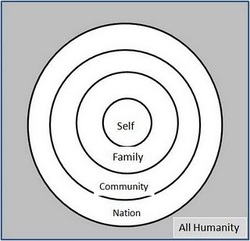Well, a look in the dictionary tells us that world is a noun and can mean:
1 : the earth and all the people and things upon it
2 : people in general : HUMANITY
3 : the system of created things : UNIVERSE
4 : the concerns of the earth and human affairs
5 : human society
6 : a class of persons sharing a common interest or activity
7 : a part or section of the earth and the people who live in it
8 : the scene of one's life and action
The word view,in this instance, is a noun and can mean:
1: the act of seeing or examining
2 : OPINION
3 : all that can be seen from a certain point
4 : range of vision
So, when we say world view, we mean the way that we see the many worlds we live in. There are many influences on how we see our worlds--our heritage, our family, where we live, what experiences we've had, what we like to do, our friends, our teachers, the type of government we have, even the type of home we live in!
Knowing what influences each one of us can help us to make choices about how we write to influence others.

This week, use the World View worksheet and map your worlds and influences. You'll already have had some time to do this and some discussion about this during our Monday class. Then, write a poem--using the guide I've provided--and post it on your blog. It is a first draft.
Over the next 2 weeks, I would like for you to visit the blogs and read everyone's poem.
- I'd like for you to identify one ABSTRACT word that the author can UNPACK.
- I'd also like for you to make a quick comment about something you learned about that person that you didn't know or that surprises you.
Where I'm From By Scott I am from Texas
where deep in the heart lies Austin.
I am from the sunny Saturday afternoons
of Texas Longhorn football games.
I am from sports
and the lessons that I learn from these games
I play with all my ability and enjoy the victories.
I am from my family, friends,
and awesome food.
I am from my grandmother's warm pies
and my parents cooking, from which
I grew to be a large boy.
I am from Texas barbeque
which smells and tastes like none other.
Although I cannot have it right now
I can still remember.
I am from Tennessee
where I live at the Foothills of the Smokies
and enjoy hiking on clear days.
I am from lessons in literature
and the sounds of a saxophone.
I am from the try your hardest
and never give ups.
I'm from my hard work
and the present as I continue on life's journey.

 RSS Feed
RSS Feed